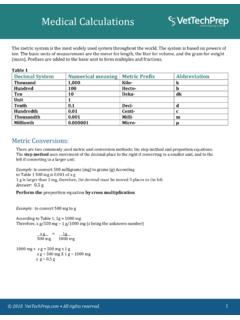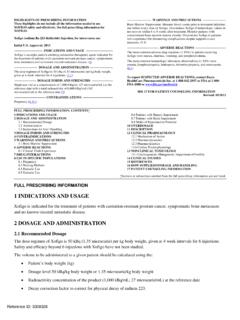Transcription of Nursing Calculations Workbook - Middlesex University
1 LDU Maths, Stats and Numeracy Support Metric Conversions Here are some metric weights arranged in size order, starting with the biggest:- Kg (kilogram) g (gram) mg (milligram) mcg (microgram). Each one is a thousand (1000) times smaller than the one before. The same rule applies for the metric volumes below L (Litre) ml (millilitre). If you want to convert from big to small you multiply by 1000 by moving the decimal point 3 places to the right. If you want to convert from small to big you divide by 1000 by moving the decimal point 3 places to the left. Example 1: Convert kg to g Answer 1: 7500 g Example 2: Convert 7280 mcg to mg Answer 2: mg Example 3: Convert Litres to ml Answer 3: 1500 ml Example 4: Convert 55 ml to Litres Answer 4: litres Try the following questions 1) Convert g to mg 2) Change 75 mcg to mg 3) Convert mg to mcg 4) Change 950 mg to g 5) Convert Litres to ml 6) Change 452 ml to Litres Page 1. LDU Maths, Stats and Numeracy Support Metric Conversions ANSWERS.
2 1) 4560 mg 2) mg 3) 780 mcg 4) g 5) 500 ml 6) Litres Page 2. LDU Maths, Stats and Numeracy Support Giving the Correct Amount of Tablets You can use the following formula to calculate how many tablets to give .. Example: Your patient has been prescribed 400mg ibuprofen. The tablets available are 200mg. How many tablets do you give the patient? Answer: 400 . 2 . 200 . Notice that the prescription and stock units (mg) must be the same. Try the following questions 1) A patient has been prescribed 40 mg. The stock tablets you have are 20 mg. How many tablets do you give the patient? 2) A patient has been prescribed mg. The stock tablets you have are 30 mcg. How many tablets do you give the patient? 3) The stock tablets you have are 600 mcg. A patient has been prescribed mg. How many tablets do you give the patient? 4) A patient has been prescribed 750 mg TDD (total daily dose). The stock tablets you have are 250 mg. How many tablets do you give the patient in a day?
3 5) A patient has been prescribed 750 mg TDD in 3 divided doses. The stock tablets you have are 250 mg. How many tablets do you give the patient for a single dose? 6) A patient has been prescribed 200 mg every 4 hours. The stock tablets you have are 100 mg. How many tablets do you give the patient in a day? Page 3. LDU Maths, Stats and Numeracy Support Giving the Correct Amount of Tablets ANSWERS.. 1) 2 .. 2) mg = 60 mcg . 2 .. 3) mg = 1200 mcg . 2 .. 4) 3 .. 5) . 250 " . 250. 1 . 250.. 6) . 6 " %. 200 x 6 = 1200 mg per day .. 12 " %. Page 4. LDU Maths, Stats and Numeracy Support Giving the Correct Amount for Injection You can use the following formula to calculate volumes for injection & ' ( ). ' ( ).. Example: Your patient has been prescribed 50mg of pethidine as injection. The stock strength available is 100mg in 1ml. How many ml do you give the patient? Answer: *+ , *- . ml *+ . Notice that prescription and stock units (mg) must be the same.
4 Try the following questions 1) A patient has been prescribed 2mg of Pethidine. The stock strength you have is 10mg/ml. How many ml do you give the patient? 2) 40 units of Insulin have been prescribed. It is dispensed as 100 units in 1ml. How much do you give? 3) Ampoules of Morphine contain 10mg in 2ml. What volume must be drawn up to give 8mg? 4) The patient needs 250 mcg of Drug X. You have 1 mg in 1 ml. How many ml do you give? 5) of drug X is required. Stock is mg in 2 ml. What volume do you give? 6) of drug is ordered. Available stock on the ward is 500mg/5ml. Calculate the volume to be drawn up for injection. 7) ml is given; it should have been How many times too much is this? Page 5. LDU Maths, Stats and Numeracy Support Giving the Correct Amount for Injection ANSWERS. , . 1) .. , . 2) .. /, . 3) .. , . 4) .. , , . 5) .. 3 . , . 6) .. 7)10 times too much. Every time the decimal point moves 1. place this is a factor of 10.
5 Page 6. LDU Maths, Stats and Numeracy Support Body weight Calculations (single dose). To work out the dosage based on the weight of the patient use the following formula dosage required = prescription x body weight Example: Mrs B has been prescribed Ibuprofen 5mg/kg/dose. She weighs 60 kg. Calculate how much Ibuprofen you will give her. Answer: 5 mg x 60 = 300 mg Note, the answer is never in kg (this only refers to the body weight ). Try the following questions 1) A patient has been prescribed Erythromycin, 40 mg/kg/dose. He weighs 74 kg. What is the dosage in mg? 2) A male patient weighs 90 kg and has been prescribed, mg/kg/dose of drug X. How many mg will he need for a single dose? 3) Cloxacillin, 50 mg/kg/dose has been prescribed to a patient, whose weight is 45 kg. a) How many mg are required for a single dose? b) How many grams is this? 4) A female patient has been prescribed Chloramphenicol, 40 mg/kg/dose. She weighs 78 kg.
6 How many grams of the drug does she require for each dose? 5) A patient weighs 60kg and requires 40 mcg/ kg of a drug. a) How many mcg are required? b) How many mg is this? 6) A patient who is 5 years old and weighs 20 kg has been prescribed 5 mcg per kilogram body weight of Digoxin elixir. The Digoxin elixir is available as 50 mcg per ml. a) How many mcg does the patient require per single dose? b) What volume will you give the patient at each dose? Page 7. LDU Maths, Stats and Numeracy Support Body weight Calculations (single dose). ANSWERS. 1) 40 x 74 = 2960 mg 2) 90 x = 90 + 45 = 135mg 3a) 50 x 45 = 2250mg 3b) g 4) 78 x 40 = 3120mg = g 5a) 60 x 40 = 2400mcg 5b) = mg 6a) 20 x 5 = 100mcg . 6b) & 1 = 2 ml . Page 8. LDU Maths, Stats and Numeracy Support Body weight Calculations (TDD and divided doses). Sometimes the dose of a drug is written as a Total Daily Dose (TDD) usually given in 3. or 4 divided doses. It is very important that you notice the difference between a TDD and a single dose otherwise you could give 3 or 4 times too much!
7 Also you need to know that bd means twice a day, tds means 3 times a day and qds means 4 times a day. Sometimes medicines are given every 4 hours (6 times a day). Example: Mrs B has been prescribed Ibuprofen 5mg/kg/day in 3 divided doses. She weighs 60 kg. a) Calculate her daily dose. b) Calculate a single dose Answer: a) TDD = dose x body weight = 5 mg x 60 = 300 mg/day 011 . b) Single dose = = 100mg/single dose . Try the following questions 1) Mrs K has been prescribed Amoxicillin, 45 mg/kg/day and she weighs 50 kg. How many mg of Amoxicillin will you give her for the whole day? 2) A patient, whose weight is kg, has been prescribed Drug X, 10 mg/kg/day in 3 divided doses. a) Calculate his TDD. b) Calculate the single dose. 3) A patient has been prescribed Capreomycin sulphate, 5 mg/kg qds. He weighs 94 kg. What is his total daily dose? 4) A patient has been prescribed Cephalothin, 20 mg/kg tds. She weighs 67 kg, what will be her total daily dose in grams?
8 5) A patient has been prescribed Chloramphenicol, 45 mg/kg/day in 4 divided doses. She weighs 70 kg. a) What is her TDD? b) What is the single dose? Page 9. LDU Maths, Stats and Numeracy Support Body weight Calculations (TDD and divided doses). ANSWERS. 1) 45 x 50 = 2250 mg 2a) x 10 = 675 mg per day . 2b) 225 mg per single dose . 3) 5 x 94 x 4 = 94 x 20 = 1880 mg 4) 20 x 67 x 3 = 67 x 60 = 4020 mg = g 5a) 45 x 70 = 3150 mg TDD. 5b) 3150 4 = mg Page 10. LDU Maths, Stats and Numeracy Support Infusion Rate Calculations (ml/hour). 2 ' 3' " ( ). 4 ( ' ). Example: A patient is to receive 4 Litres of normal saline over the next 8 hours. What is the infusion rate in millilitres per hour (ml/hour)? Answer: First convert the 4 Litres to ml, which is 4000 ml then substitute it into the formula: . 500 ml/hour / . Try the following questions 1) 800 ml of fluid in a burette is to be infused over 2 hours? What is the infusion rate in millilitres per hour?
9 2) 500 ml of Hartmann's solution is to be given to a teenager over 8 hours. What is the infusion rate in ml/hour? 3) Over a period of 16 hours, a patient is to receive Litres of dextrose 4%. What is the infusion rate in ml per hour? 4) A doctor requests of Crystalloid X to be infused over 6 hours using a pump. At what rate in ml/hr should the infusion be administered? 5) Half a litre of Dextrose to be given over 4 hours. What is the rate in ml/hour? 6) The doctor prescribes 1000 ml of 5% Dextrose in normal saline to be infused over 6 hours. How many ml per hour is this? 7) A patient receives 50ml of saline in half an hour. What is the rate in ml/hour? 8) What is the rate in ml/hour for 20 ml of fluid to be given over a quarter of an hour? Page 11. LDU Maths, Stats and Numeracy Support Infusion Rate Calculations (ml/hour). ANSWERS. / . 1) 400 ml/hour. Remember you must include the unit, ml/hour for a . full and correct answer.
10 2) = = = = Now round your answer to a whole number / . = 63 ml/hour . 3) Litres = 2400 ml, = = = = 150 ml per hour. Notice / . how the 4% is irrelevant to this question so you do not need it in your calculation .. 4) L = 750 ml. = = 125 ml/hour .. 5) = = 125 ml/hour .. 6) = = up to 167 ml/hour . 7) 50 ml in HALF an hour = 100 ml in 1 hour. So the rate is 100ml/hour 8) 20 ml x 4 (as there are 4 quarters in an hour) = 80 ml /hour Page 12. LDU Maths, Stats and Numeracy Support Infusion Rate Calculations (drops/minute). ' 3' " ( ) " . &. ' 60. Example: A patient is to receive 1 Litre normal saline over the next 4 hours. What is the infusion rate in drops per minute if the drop rate is 15? Answer: First convert 1L to ml, which is 1000 ml, and then substitute into the formula: . & & / . Remember to round your answer to the nearest whole number = 63 drops per minute. Try the following questions 1) Half a litre of fluid is to be given over 5 hours.









